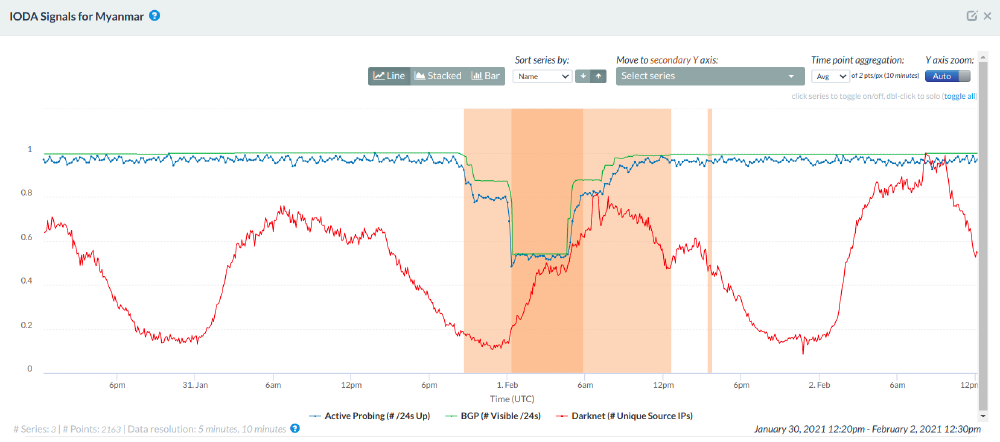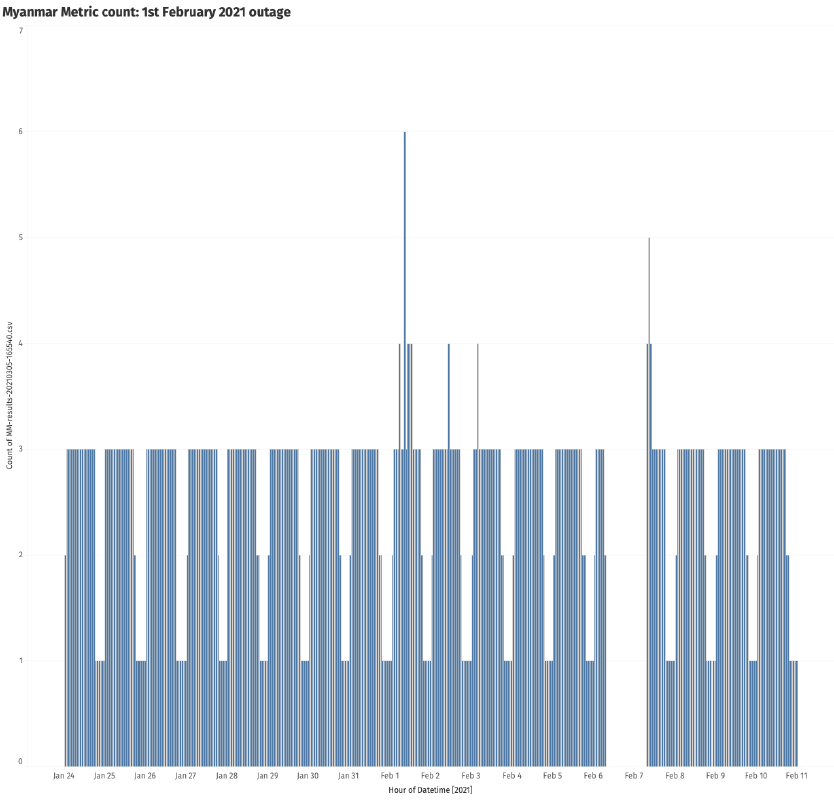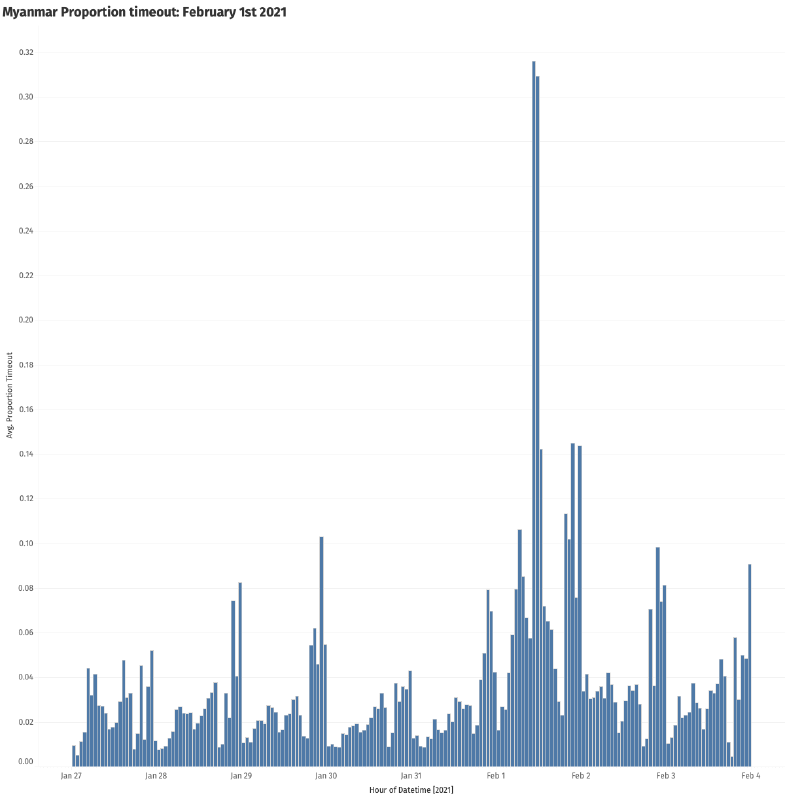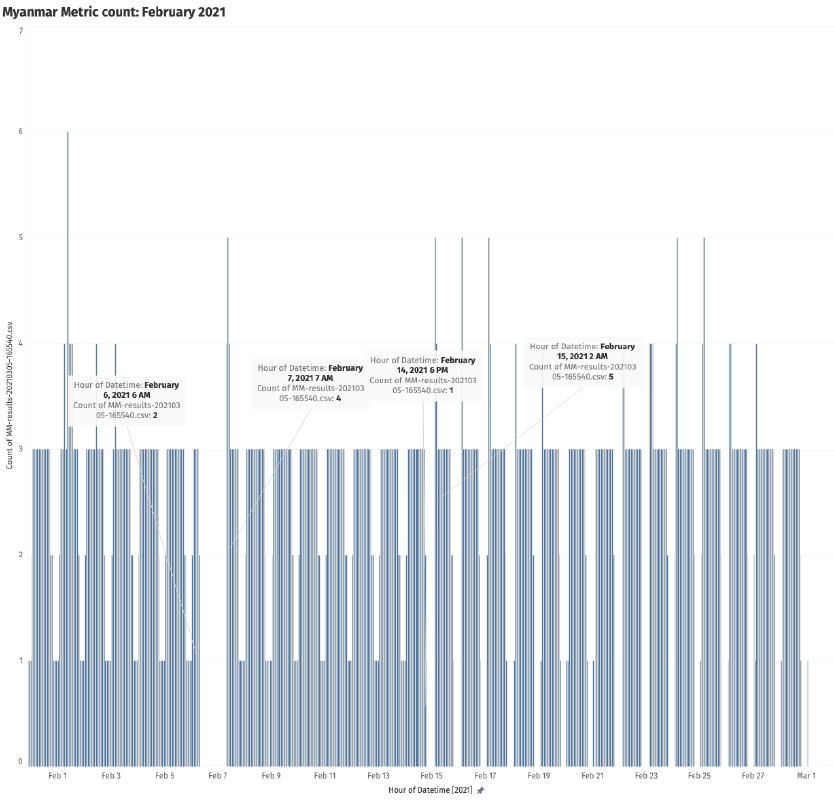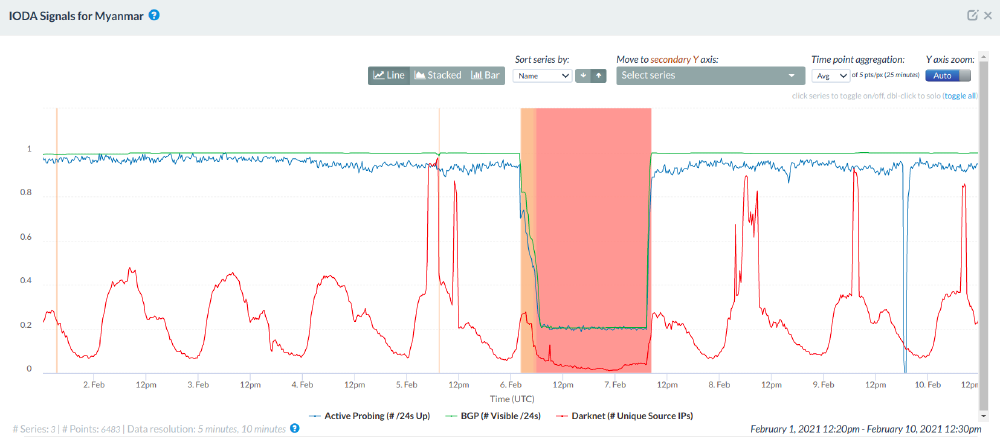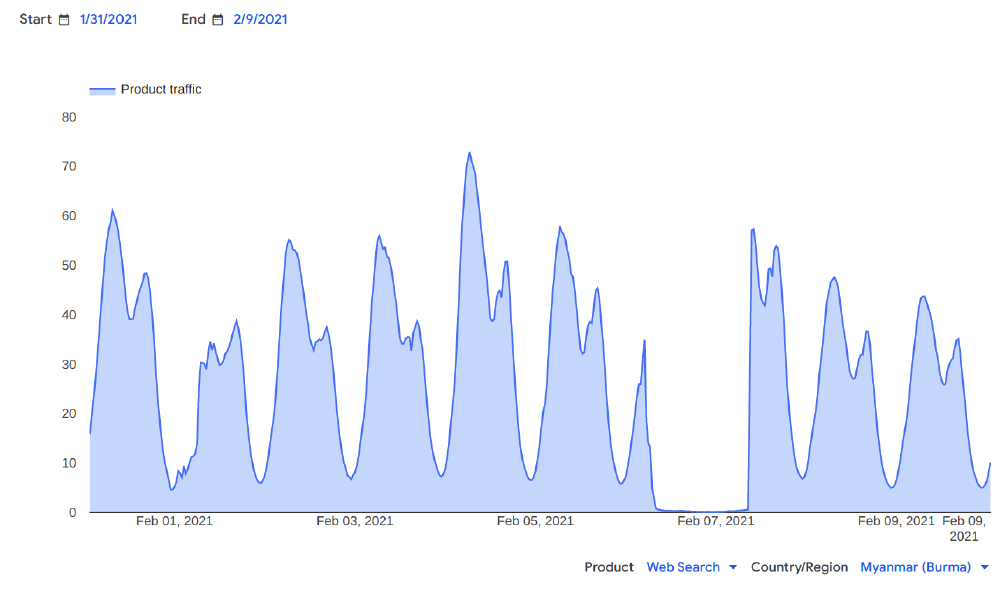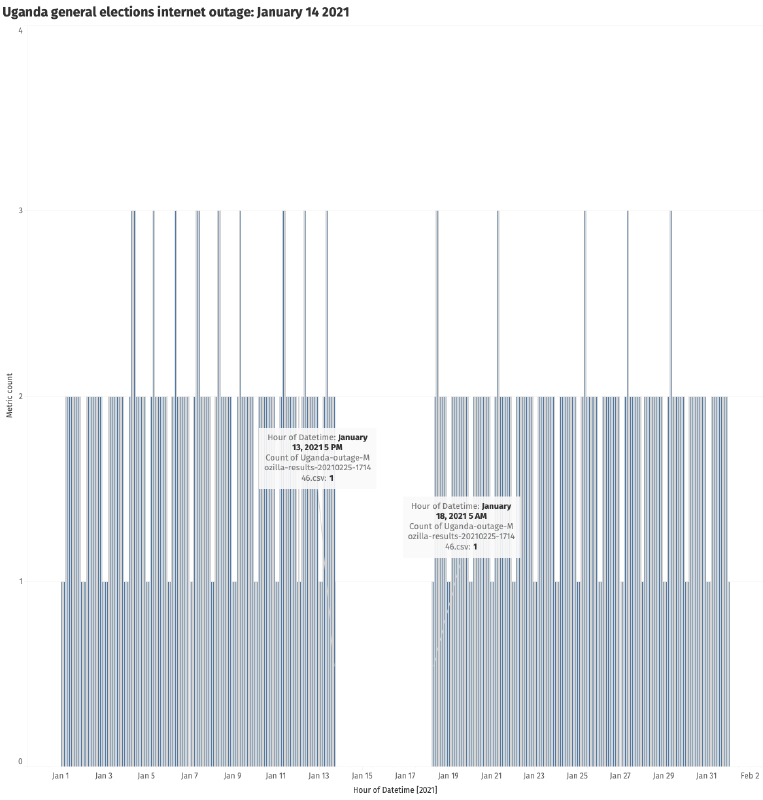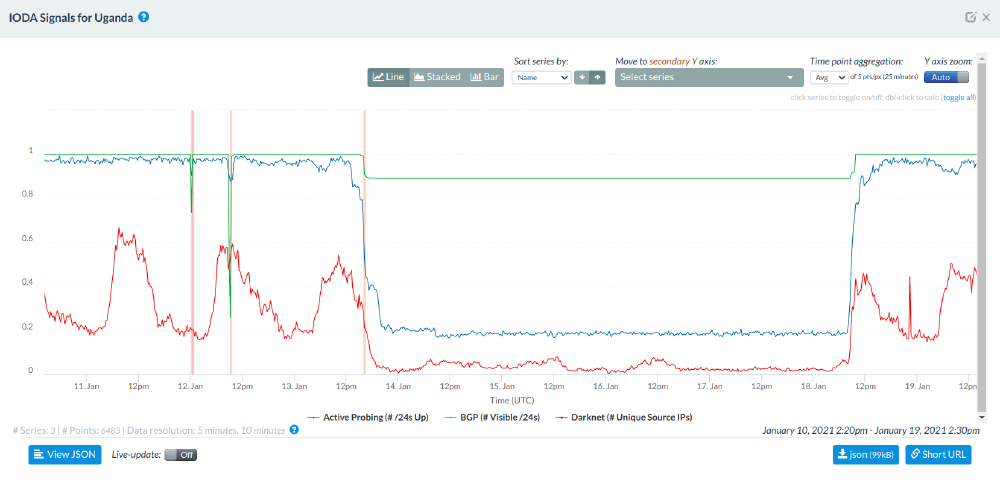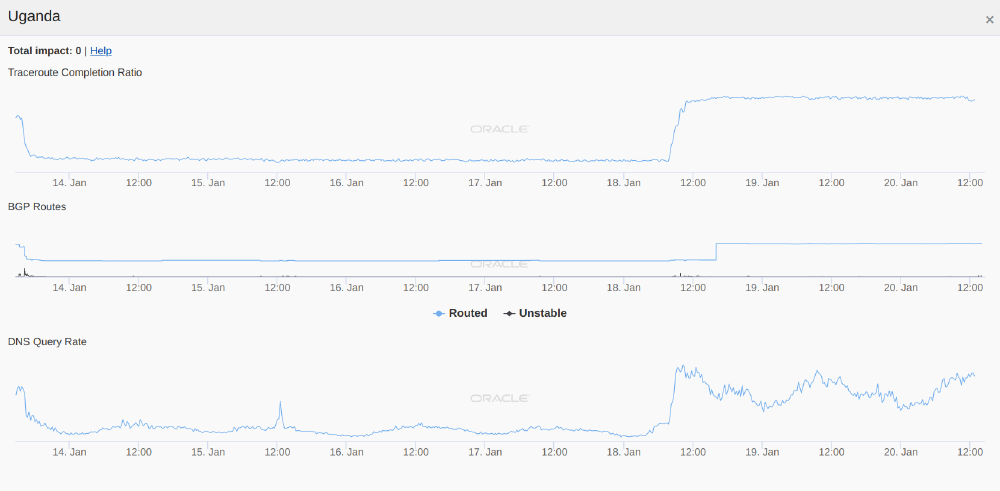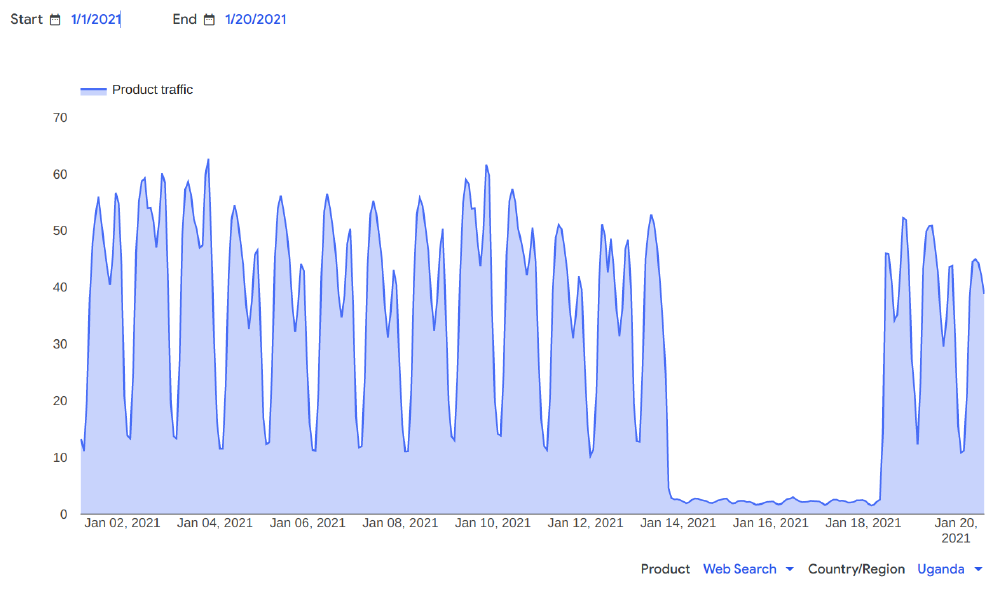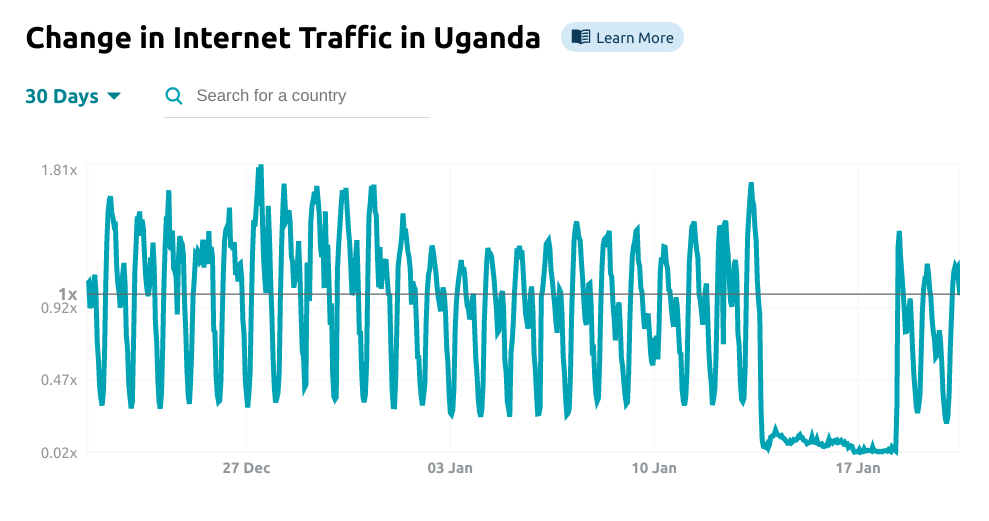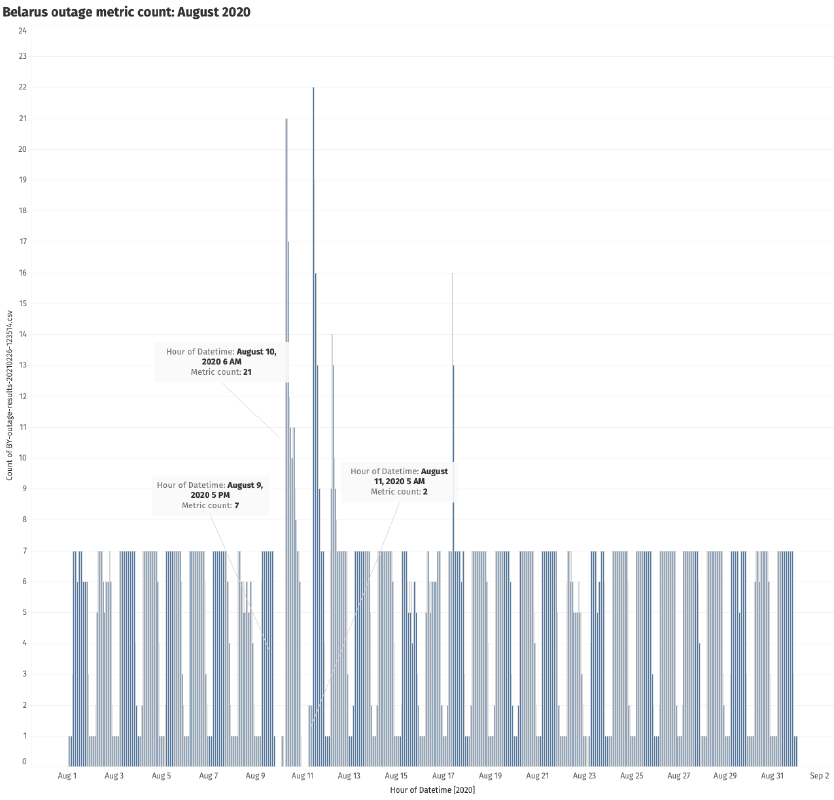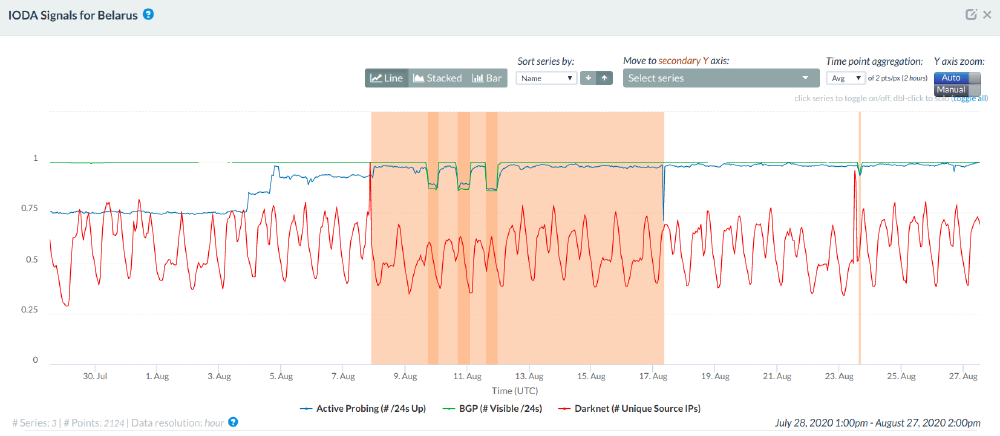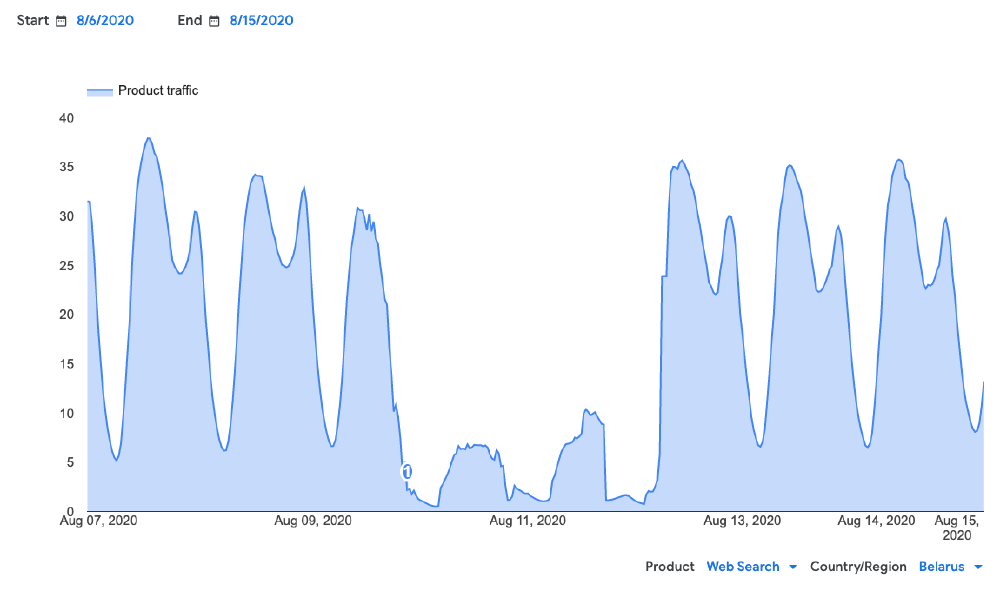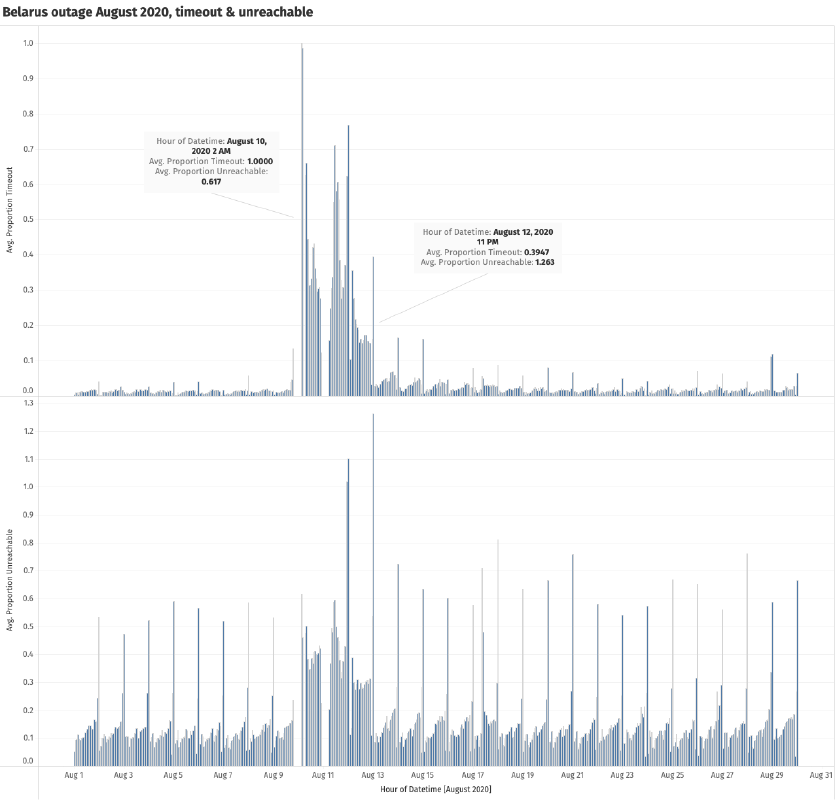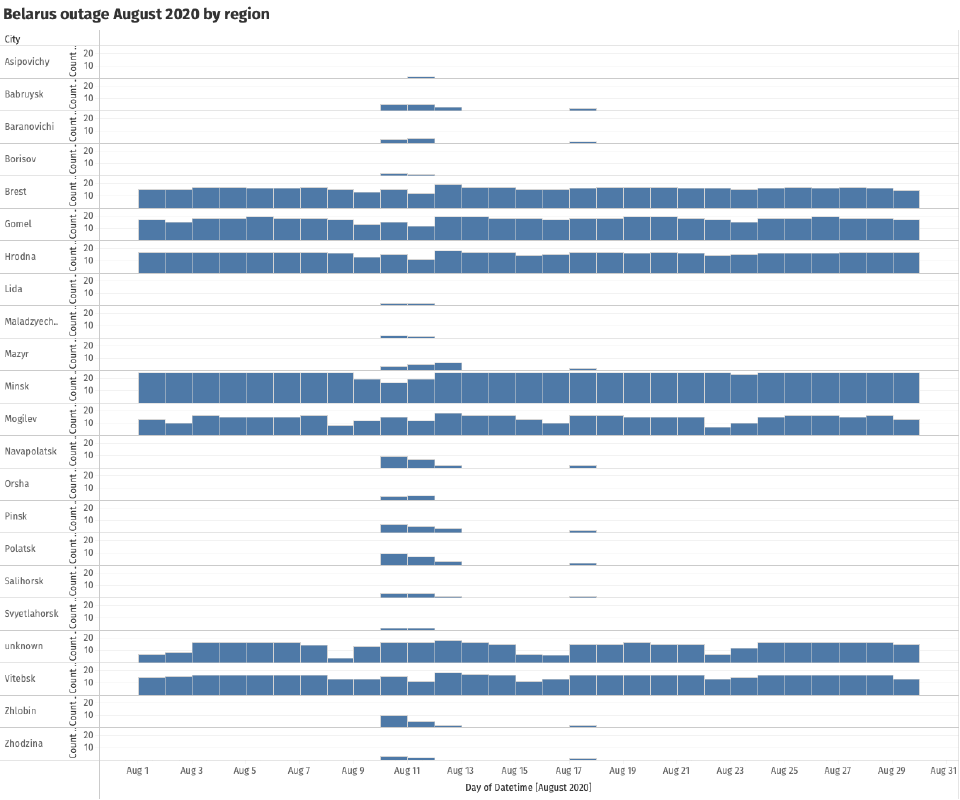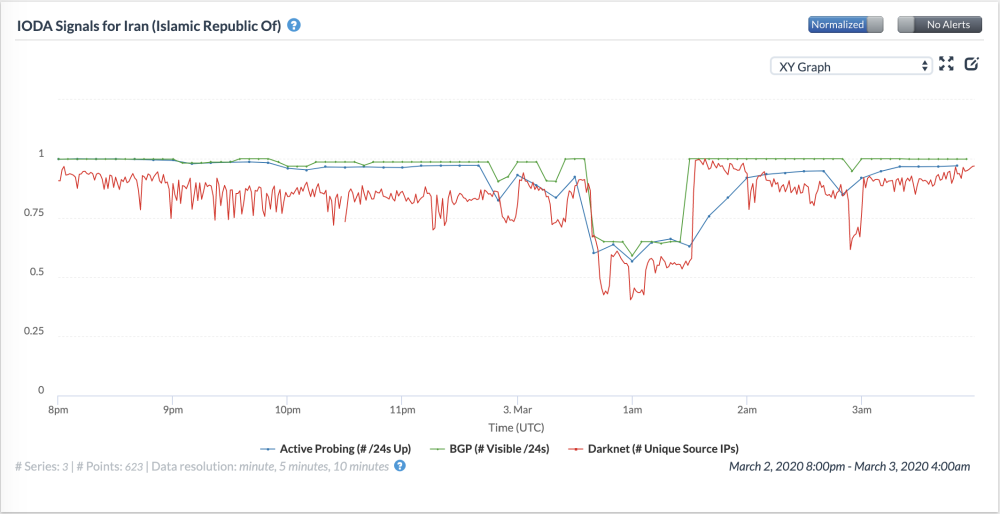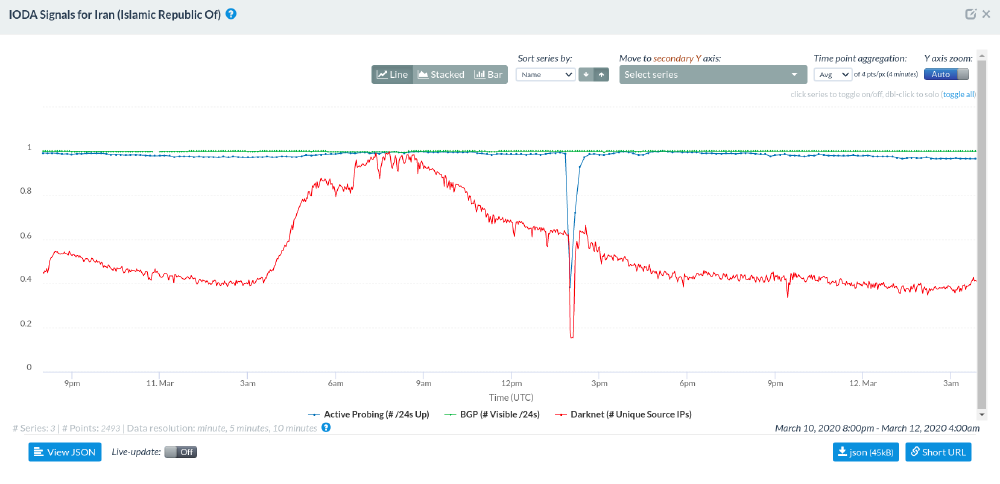Investigating Internet shutdowns through Mozilla telemetry
More than 200 million users worldwide use the Firefox web browser (developed by Mozilla) every month.
If access to the Internet is shut down in a country, Mozilla should expect to see a dramatic drop in Firefox usage from that country. Given how widespread the use of Firefox is around the world, could Mozilla telemetry be a valuable resource for the Internet freedom community to investigate Internet shutdowns?
To explore this question, the Open Observatory of Network Interference (OONI) and Internet Outage Detection and Analysis (IODA) teams joined forces to analyze a dataset of potential outage signals gathered through regular Mozilla telemetry, access to which was provided by Mozilla as part of a relevant research project to validate assumptions about the data.
In this report, we share our findings from analyzing Mozilla telemetry to investigate Internet connectivity shutdowns in Myanmar, Uganda, Belarus, and Iran.
Our analysis demonstrates that Mozilla telemetry is not only a valuable resource for investigating Internet connectivity shutdowns worldwide, but that it also provides novel insights. We share recommendations for improving the research use of Mozilla telemetry.
Introduction
How can we verify that access to the Internet has (intentionally or unintentionally) been shut down in a country? We often hear of Internet shutdowns occurring worldwide from media reports and advocacy campaigns, but which data sources can we refer to?
There are a number of public datasets that shed light on whether access to the Internet has been shut down in a country. Some of these datasets (such as IODA) are specifically designed to measure Internet outages, but you can also potentially infer the presence of Internet shutdowns through the absence of data from other Internet-wide measurement datasets (such as RIPE data, M-Lab data and, in some cases, OONI data). If an Internet-wide measurement dataset contains a stable volume of data from a specific network over a long period of time, a drop in volume of data could potentially signal the absence of Internet connectivity.
Tor Metrics show the number of directly connecting Tor users from a given country. Similarly, the Psiphon Data Engine shares the number of daily Psiphon users from each country. If the number of Tor or Psiphon users drops dramatically to almost no users, that may be a signal that the country in question is experiencing an Internet shutdown (since Internet connectivity is required to use Tor and Psiphon). But in the case of Tor and Psiphon (which are censorship circumvention tools), a drop in their usage may also be the result of their blocking (as governments tend to block circumvention tools in an attempt to prevent censorship circumvention), rather than a country-wide Internet connectivity shutdown.
This highlights the need to check whether drops in Internet connectivity signals are present in multiple independent datasets for the same country, during the same time period. It also suggests that it’s useful to check Internet traffic towards popular services, which governments are less likely to shut down.
As Google services are widely used in most countries, Google traffic data (which illustrates the volume of Internet traffic towards Google products and services) is a great example of this. A significant drop in Google traffic (in comparison to previous levels in that country) often provides a signal of an Internet connectivity shutdown (as Internet access is required to use Google products and services). However, Google currently publishes its datasets aggregated at the granularity of entire countries, precluding the ability to detect Internet connectivity shutdowns that target a specific sub-national region or a network within a country.
With more than 200 million users worldwide every month, can Mozilla telemetry – gathered only from Firefox web browser users who have data reporting enabled – be another useful source for investigating and potentially corroborating Internet connectivity shutdowns worldwide?
To evaluate this question, Mozilla provided us access to specific aggregated data points (which did not contain any personal information) about network activity from Firefox telemetry in a dataset which spans from January 2020 to date.
We selected 4 case studies based on countries (Myanmar, Uganda, Belarus, Iran) where Internet shutdowns are known to have occurred (based on public datasets and reports) from January 2020 onwards (the starting date of Mozilla telemetry that we have access to).
Ultimately, with this study we aim to evaluate how useful Mozilla telemetry is for the Internet freedom community in researching Internet connectivity shutdown events worldwide.
Note: We use the terms “outages” and “shutdowns” interchangeably to refer to the complete disruption of Internet connectivity. The partial shutdown of specific Internet services (such as the blocking of apps) is out of scope in this study because Mozilla telemetry does not involve such tests.
Methods
To evaluate whether Mozilla telemetry can be helpful in examining Internet connectivity shutdowns, we:
Selected case studies. The case studies were chosen based on countries that are known to have experienced Internet connectivity shutdowns within the Mozilla telemetry date range that we have access to (from January 2020 to date).
Analyzed Mozilla telemetry. Our analysis involved the 4 countries (Myanmar, Uganda, Belarus, Iran) that we selected as case studies.
Compared Mozilla telemetry with other public datasets. We compared public data (such as IODA and Google traffic data) with Mozilla telemetry on the selected case studies.
Based on this comparison, our goal was to explore whether it is possible to observe signals of Internet connectivity shutdowns through Mozilla telemetry within the date ranges of selected case studies. We also aimed to understand the potential strengths and limitations of Mozilla telemetry in examining Internet connectivity shutdowns.
Case studies
We selected case studies to explore whether signals of Internet connectivity outages are visible in Mozilla telemetry.
Our criteria for selecting these case studies include:
Date range of Mozilla telemetry. The date range of Mozilla telemetry that we have access to spans from January 2020 to date. We therefore needed to select cases of Internet outages that occurred from January 2020 onwards.
Countries that are known to have experienced Internet connectivity shutdowns from January 2020 onwards. To compare Mozilla telemetry with other public data sources, we selected countries that are known to have experienced Internet connectivity shutdowns (based on media reports and signals from relevant public datasets) during the Mozilla telemetry date range.
Internet connectivity shutdown cases that occurred during political events. When access to the Internet is shut down during a political event (such as elections or protests), it is possible that such a shutdown was intentional and that its timing had a larger public impact. It is therefore important to monitor such shutdown events (which are more relevant from a socio-political perspective) and to evaluate whether they are visible through Mozilla telemetry.
Internet connectivity shutdowns previously reported by OONI and/or IODA. We further narrowed our case study selection to Internet shutdown events that OONI and/or IODA had already reported on from January 2020 onwards. Having previously performed relevant analysis and published reports, such case studies enabled us to have a more in-depth understanding, facilitating more accurate comparison with Mozilla telemetry. However, we acknowledge our bias in our case study selection.
Based on these criteria, we selected the following case studies:
Myanmar. We examine two Internet outages that occurred following the February 2021 military coup.
Uganda. We examine the 4-day nationwide Internet outage amid its January 2021 general election.
Belarus. We examine the Internet outages amid its 2020 presidential election.
Iran. We examine two Internet outages in March 2020 following its February 2020 legislative election.
Analysis of Mozilla telemetry
For the purpose of this research, Mozilla provided us access to an aggregated dataset of network activity based on Firefox web browser usage worldwide. This telemetry dataset spans from January 2020 to date.
Mozilla telemetry data is only collected from Firefox browser users who have data reporting enabled, reporting information on certain networking related metadata when browsing the web. As such, Mozilla telemetry provides a representation of the user experience when accessing the web. This telemetry has been aggregated to build privacy protections in the data.
The telemetry dataset which has been made available to us is an aggregate of pings sent by Firefox clients.
A row of the data looks something like this:
country,city,datetime,proportion_undefined,proportion_timeout,proportion_abort,proportion_unreachable,proportion_terminated,proportion_channel_open,avg_dns_success_time,missing_dns_success,avg_dns_failure_time,missing_dns_failure,count_dns_failure,ssl_error_prop,avg_tls_handshake_time
Each row represents the various aggregate metrics (percentage of failures, timing information, counts) over a window of 1 hour in a specific country or city. The aggregation is performed on an hourly basis, but cities which have less than or equal to 50 hourly active users are filtered out.
To analyze Mozilla telemetry as part of this study, we queried the dataset based on the 4 countries that we selected as case studies. For each country, we queried the dataset based on the date range(s) of the Internet shutdown events (selected as part of the case studies). We then checked whether we could observe a drop in metrics or a complete absence of metrics within that date range (in comparison to previous levels before and after the Internet shutdown event), which could provide a signal of a potential Internet outage. We also checked whether we could observe a spike in connection timeouts (or other errors), which could signal a disruption in Internet connectivity (in cases where the Internet shutdown does not affect all networks in a country).
Based on our analysis of Mozilla telemetry, we produced relevant charts, which we share in the Findings section below.
Limitations
The Mozilla dataset provides location granularity in terms of
country and city, which is very useful for potentially detecting
localized Internet outages that only affect specific cities or regions
(such as the Internet shutdowns in Jammu and Kashmir). However, it does not provide
Autonomous System Number (ASN) level information, which
is essential for identifying the specific AS network that is impacted by
an Internet outage. In Iran, for example, we observed network-level differences
during the nationwide Internet shutdown in November 2019. The absence of
ASN information in Mozilla telemetry therefore presents a limitation in
detecting Internet shutdowns that only occur on certain networks.
The datetime column in Mozilla telemetry indicates when the metric
was submitted to Mozilla’s telemetry backend, but not the time in
which that particular metric was computed on the client. As clients will
store and attempt to re-transmit the metrics at a later stage, these two
times can vary quite dramatically during an Internet outage event. This
therefore presents a limitation in evaluating the correct timing of a
metric.
As part of this study, the primary metric we used for detecting an outage event is the number of distinct locations that are able to submit telemetry data to Mozilla servers. But when looking at other metrics, such as the average percentage of connection timeouts, the exact timing of when these metrics were recorded is quite unclear. Moreover, Mozilla telemetry is aggregated on an hourly basis, which presents the risk of missing short-lived Internet connectivity shutdowns (which last less than an hour).
Given that Mozilla telemetry is aggregated and doesn’t contain information on the testing of endpoints, we cannot use it to examine the blocking of specific Internet services (and, therefore, cannot compare it against OONI measurement data). Rather, Mozilla telemetry is more useful for examining Internet connectivity shutdowns by checking whether a dramatic drop or absence of metrics is visible during a reported Internet shutdown event.
Comparison of Mozilla telemetry with other public datasets
False positives can occur (particularly in Internet measurement data), and datasets usually present limitations.
IODA signals, for example, may miss certain Internet outages (particularly if they only affect cellular networks), while Google traffic data may not reflect Internet outages that only impact certain networks or regions. Mozilla telemetry shares city-level granularity (which IODA does not), but does not provide network-level granularity (which IODA does). The absence (or dramatic drop) of Tor or Psiphon metrics may signal the presence of an Internet outage, or that may be the result of those tools being blocked in the specific country.
In short, it is necessary to adopt a more holistic approach, examining potential Internet connectivity shutdowns through the comparison of relevant datasets.
We therefore compared Mozilla telemetry with other public datasets for the selected case studies of this research. Based on the analysis of Mozilla telemetry, we checked whether we could observe a significant drop in metrics or a complete absence of metrics within the date range of a selected case study, in comparison to metrics for the same country and date range in other public datasets (such as IODA and Google traffic data).
Our hypothesis is that if we observe a similar drop or absence of metrics in Mozilla telemetry in comparison to other relevant public datasets (for the same country and date range), Mozilla telemetry can be a useful data source for examining Internet connectivity shutdowns. However, if we do not observe a significant drop or absence of metrics in Mozilla telemetry, that may reflect limitations to the dataset, and/or suggest that the Internet outage in question did not have a large impact (if Firefox clients were still able to submit metrics). The hourly granularity of Mozilla telemetry (as opposed to being near real-time) may also present the risk of short-term outages (that last less than 1 hour) not being recorded.
Investigating Internet shutdowns
To evaluate whether Mozilla telemetry can be useful in investigating Internet connectivity shutdowns, we analyzed Mozilla telemetry and compared it against relevant public datasets involving 4 country-specific case studies in Myanmar, Uganda, Belarus, and Iran.
We share our analysis and findings in the sections below.
Myanmar
On 1st February 2021, the military in Myanmar carried out a coup d’etat, seizing power and detaining the country’s State Counsellor (equivalent to a prime minister) and other democratically elected leaders. On the same night, IODA data suggests that an Internet outage occurred.
As we can see from the chart below, IODA illustrates a drop in both Active Probing and BGP signals.
Source: Internet Outage Detection and Analysis (IODA), IODA Signals for Myanmar, https://ioda.caida.org/ioda/dashboard#view=inspect&entity=country/MM&lastView=overview&from=1612051200&until=1612224000
When looking closer at the outage, we can see that it does not appear to affect all networks in the same way. Some networks experienced almost complete loss of Internet connectivity, while others appear to have only experienced small outages.
For the purpose of confirming the outage, we looked at the number of datapoints present in Mozilla telemetry data and searched for “holes” in the data. A “hole” is when no clients are able to report back any data to Mozilla telemetry servers.
When comparing IODA signals (from the Internet outage in Myanmar on 1st February 2021) to Mozilla telemetry data, we can see that the outage is not very visible in the overall metrics count chart (which looks at how many locations in a given hour were able to report back metrics to the telemetry server).
Source: Mozilla telemetry data from Myanmar (24th January 2021 to 11th February 2021): Custom overall metrics count chart.
But when looking at Mozilla’s metric on “Average Proportion Timeout”, we notice a spike in the percentage of connections which timeout.
Source: Mozilla telemetry data from Myanmar (January 2021 to February 2021): Custom chart on Average Proportion Timeout.
The spike in connection timeouts (as illustrated in the above chart) could potentially provide a signal of an Internet disruption. However, this data is presented with a lag because the timestamp of Mozilla telemetry is based on data submission, rather than on the timing of the measurement being performed.
Yet, the fact that there is not a complete absence of data seems to indicate that this outage only affected a subset of all networks in the country, as several clients were still able to submit metrics during the period of the outage. IODA data appears to corroborate this hypothesis, as it shows that not all AS networks in Myanmar were impacted by the Internet outage.
When a second Internet outage occurred in Myanmar a few days later (on 6th February 2021), Mozilla telemetry provided a strong signal as we observe the complete absence of metrics during that period.
Source: Mozilla telemetry data from Myanmar (February 2021): Custom chart showing the absence of Mozilla telemetry on 6th February 2021.
As we can see from the above chart, starting from 6th February 2021 at 06:00 UTC until 7th February 2021 at 07:00 UTC, there is a complete absence of data points, strongly suggesting that an Internet connectivity shutdown event occurred. Compared to the first Internet outage on 1st February 2021 (during which some network connectivity was still present), this second outage (on 6th February 2021) was much more severe and pervasive, as no Mozilla telemetry clients were able to report back any data.
The severity of the second Internet outage on 6th February 2021 is also illustrated in IODA data (below), which shows a major drop in both Active Probing and IBR signals, as well as a drop in the BGP signal correlating in time with the drop in the other signals. This strongly suggests that Myanmar experienced a widespread internet outage, corroborating the signal seen previously in Mozilla telemetry.
Source: Internet Outage Detection and Analysis (IODA), IODA Signals for Myanmar, https://ioda.caida.org/ioda/dashboard#view=inspect&entity=country/MM&lastView=overview&from=1612310400&until=1612915200
Similarly, Google traffic data very visibly shows that almost no Google traffic originated from Myanmar during the same time period, as illustrated below.
Source: Google Transparency Report, Traffic and disruptions to Google: Myanmar (February 2021), https://transparencyreport.google.com/traffic/overview?hl=en&fraction_traffic=start:1612051200000;end:1612915199999;product:19;region:MM&lu=fraction_traffic
When comparing Mozilla telemetry, IODA data, and Google traffic data, we observe absence of relevant metrics during the same time period in Myanmar. The Internet outage on 6th February 2021 is further indicated by the fact that we see the signals from all 3 datasets resume to their previous levels thereafter.
Overall, our comparison of Mozilla telemetry from Myanmar with other (relevant) public data sources shows that:
High impact Internet connectivity shutdowns which affect all networks are visible through Mozilla telemetry (when access to the Internet is shut down completely and Firefox users cannot submit telemetry to Mozilla servers);
Lower impact Internet connectivity shutdowns which only affect certain networks are not visible through the overall Mozilla telemetry count, but can potentially be inferred if Mozilla metrics display a high percentage of connection timeouts.
Uganda
On 13th January 2021, on the eve of Uganda’s 2021 general election, the country was disconnected from the Internet entirely. The nationwide Internet connectivity shutdown lasted for 4 days, with Internet access being restored on the morning of 18th January 2021.
In this case study, we compare Mozilla telemetry with IODA, the (now discontinued) Oracle Internet Intelligence map, Google traffic data, and Cloudflare radar data to explore whether Uganda’s 4-day Internet connectivity shutdown is visible in Mozilla telemetry.
When looking at the metrics reported to Mozilla telemetry services, we can see that the last successfully submitted data points were on 13th January 2021 at 17:00 UTC. What follows is a complete lack of any data which is visible as a “hole” in the chart below.
Source: Mozilla telemetry data from Uganda (January 2021): Custom chart showing the absence of Mozilla telemetry between 13th-18th January 2021.
Starting from 18th January 2021 at 05:00 UTC, we can see that traffic towards Mozilla telemetry services resumes to previous levels. The complete absence of Mozilla telemetry between 17:00 UTC on 13th January 2021 to 05:00 UTC on 18th January 2021 provides a strong indication that Uganda experienced a widespread Internet connectivity shutdown.
When we compare the above chart with IODA data, we can clearly see that the timing of the hypothesized Internet connectivity shutdown is quite consistent.
Source: Internet Outage Detection and Analysis (IODA), IODA Signals for Uganda, https://ioda.caida.org/ioda/dashboard#view=inspect&entity=country/UG&lastView=overview&from=1610280000&until=1611057600
IODA data (above) shows a major drop in both Active Probing and IBR signals, starting at around 16:00 UTC on 13th January 2021, and lasting up until around 09:30 UTC on 18th January 2021. We also observe a drop in the BGP signal correlating in time with the drop in the other signals. As we see that all these signals resume to their previous levels on 18th January 2021, IODA data strongly indicates that Uganda experienced a widespread Internet outage.
The same drop in traffic between 13th to 18th January 2021 can be seen in data from Oracle Internet Intelligence (now discontinued), Google traffic data, and Cloudflare radar data, as illustrated through the following charts.
Source: Oracle Internet Intelligence Map, Uganda (January 2021), https://map.internetintel.oracle.com/?root=national&country=UG (the link no longer provides relevant data because the project has recently been discontinued)
Oracle’s Internet Intelligence Map (shared above) used to track internet disruptions worldwide based on three signals: Traceroute completion ratio, BGP routes, and DNS query rate. Between 13th to 18th January 2021, Oracle’s Internet Intelligence Map (now discontinued) recorded almost identical timings in the drop of signals as IODA data.
Source: Google Transparency Report, Traffic and disruptions to Google: Uganda (January 2021), https://transparencyreport.google.com/traffic/overview?hl=en&fraction_traffic=start:1609459200000;end:1611187199999;product:19;region:UG&lu=fraction_traffic
Similarly, Google traffic data (above) shows a major drop in traffic between 13th to 18th January 2021, as almost no Google traffic originated from Uganda during this time period (but traffic resumed thereafter).
Source: Cloudflare Radar, Change in Internet Traffic in Uganda (January 2021), https://radar.cloudflare.com/ug?date_filter=last_30_days (it is currently only possible to filter CloudFlare Radar data up until 30 days ago)
Uganda’s Internet connectivity shutdown is further corroborated by Cloudflare Radar data, which also shows a major drop in traffic from Uganda between the evening of 13th January 2021 to the morning of 18th January 2021.
Similarly to our previous case study on Myanmar, our comparison of Mozilla telemetry from Uganda with other (relevant) public data sources shows that high impact Internet connectivity shutdowns which affect all networks are visible through Mozilla telemetry (when access to the Internet is shut down completely and Firefox users cannot submit telemetry to Mozilla servers).
Belarus
Amid a controversial presidential election, Belarus experienced several Internet outages between 8th to 17th August 2020, with the most heavy disruptions being noted between 9th to 12th August 2020.
In this case study, we compare Mozilla telemetry with IODA and Google traffic data from Belarus in August 2020.
Based on our analysis of Mozilla telemetry from Belarus, we have produced the following chart.
Source: Mozilla telemetry data from Belarus (August 2020): Custom chart showing the drop in Mozilla telemetry between 9th-11th August 2020.
By looking at Mozilla telemetry (above) from Belarus on the evening of 9th August 2020, we can see that the number of locations submitting metrics starts dropping at around 17:00 UTC. This is followed by a complete absence of metrics until 10th August 2020 at 17:00 UTC. Thereafter, we can see that metrics start being submitted again for some hours until 20:00 UTC. After that there is another interruption in metric submission, until traffic appears to fully resume on 11th August 2020 at 05:00 UTC.
The pattern observed in Mozilla telemetry data is consistent with what we see in the IODA Active Probing and BGP feed data.
Source: Internet Outage Detection and Analysis (IODA): Belarus (August 2020), https://ioda.caida.org/ioda/dashboard#view=inspect&entity=country/BY&lastView=overview&from=1596114973&until=1598534173
The first two drops in the evening of 9th August 2020 (between around 18:00 UTC to midnight UTC) and the evening of 10th August 2020 (between 16:00 UTC to around midnight) lineup very well with what we see in Mozilla telemetry data. We do not, however, see the third drop in Mozilla telemetry data on the next day, 11th August 2020 (during the same time period).
Google traffic data further supports these Internet disruptions, as illustrated below.
Source: Google Transparency Reports: Traffic and disruptions to Google in Belarus (August 2020), https://transparencyreport.google.com/traffic/overview?fraction_traffic=start:1595894400000;end:1598572799999;product:19;region:BY&lu=fraction_traffic
Google traffic data seems to be aligned with what is displayed in IODA data, as we observe (in the above chart) 3 drops in Google traffic originating from Belarus between 9th to 12th August 2020.
In an attempt to further characterize the Internet outages in Belarus amid its 2020 presidential election, we tried to understand why Mozilla telemetry does not display the third Internet outage that both IODA data and Google traffic data display in the evening of 11th August 2020. To this end, we looked at the average proportion of timed out connections, as well as the average proportion of connections reporting the network as being unreachable.
Based on this analysis, we produced the following chart, which includes Mozilla telemetry from Belarus on both the average proportion of connection timeouts and the average proportion of unreachable connections.
Source: Mozilla telemetry data from Belarus (August 2020): Custom charts showing the average proportion of connection timeouts and the average proportion of unreachable connections.
Starting on 10th August 2020 (as illustrated above), we observe a spike in the average proportion of connections timing out. As some telemetry continued to be submitted during this period nonetheless, it may be indicative of an unreliable connection. The high rate of connection timeouts appears to persist until at least 23:00 UTC on 12th August 2020, which is consistent with the duration of the outage observed in IODA and Google traffic data.
It is important to note though that the reported timestamps do not correspond to the exact time when the metric was collected, but to when the metric was submitted to Mozilla telemetry servers. A Mozilla metric may therefore refer to a prior period.
As for why we see this unusual pattern in Mozilla telemetry, we have the following observations and hypothesis. It could be that the outages were not “total”, but instead transitioned to being instances of throttling. Moreover, a partial outage may have resulted in certain users experiencing poor Internet connectivity for some time. It might be the case that one of the upstream ISPs for certain users was out and some backup routes had to be used.
The hypothesis of the upstream ISP going down and backup routes being used is suggested by the fact that we observe an increase in locations submitting telemetry data during the period of the outage, as illustrated below.
Source: Mozilla telemetry data from Belarus (August 2020): Custom chart showing the submission of telemetry by region in Belarus.
As is evident through the above chart, there are certain locations that only appear to report Mozilla telemetry data during the period of the outage. This indicates that there might have been some reshaping of the network topology during the outage, leading to us to see users exit from different locations.
Overall, Mozilla telemetry provides a strong signal of the first two Internet outages (on 9th and 10th August 2020) in Belarus, similarly to IODA and Google traffic data. The third outage (on 11th August 2020), however, is not directly visible through Mozilla telemetry, but can potentially be inferred through the spike in connection timeouts and unreachable connections. The fact that we see an increase in such metrics from a variety of different locations in Belarus (possibly as a result of network topology reshaping) on 11th August 2020 adds to the overall Mozilla metric count, making it harder to spot an outage on that day (in comparison to previous days).
Iran
Iran experienced two Internet outages in March 2020, following its February 2020 legislative election. The first occurred on 3rd March 2020; it only lasted for about 1 hour, but it affected several networks. The second outage occurred on 11th March 2020, only lasting for 10 minutes, but also affecting several networks.
IODA data shows that all 3 of its signals experienced a significant drop in Iran between around 00:50 UTC and 01:30 UTC on 3rd March 2020, as illustrated below.
Source: Internet Outage Detection and Analysis (IODA): Iran (March 2020), https://ioda.caida.org/ioda/dashboard#view=inspect&entity=country/IR&lastView=overview&from=1583179200&until=1583208000
IODA found that several of the affected networks (including cellular networks) had outages that began nearly simultaneously (in contrast to Iran’s November 2019 nationwide Internet shutdown), but the extent of the outages varied across providers. Interestingly, two large state-owned providers (Iran Telecom Co (AS58224) and ITC (AS12880)) only observed small outages, whereas some non-state-owned providers (such as Shatel (AS31549), Asiatech (AS43754), Mobin Net (AS50810), DATAK (AS25124)) observed outages that appeared to affect the entirety of their address-space.
A week later, on 11th March 2020, IODA showed that Iran experienced a second, but shorter (in terms of duration) Internet outage. This outage affected multiple networks at approximately 14:00 UTC and lasted less than 10 minutes.
Source: Internet Outage Detection and Analysis (IODA): Iran (March 2020), https://ioda.caida.org/ioda/dashboard#view=inspect&entity=country/IR&lastView=overview&from=1583870400&until=1583985600
Similarly to the outage on 3rd March 2020, some large non-state-owned ASes appear to have experienced a more severe outage compared to state-owned ASes during the outage on 11th March 2020.
To explore whether these outages are visible in Mozilla telemetry, we analyzed their data and produced the following charts which display the number of distinct locations submitting metrics and average proportion of connection timeouts from Iran in March 2020.
Source: Mozilla telemetry data from Iran (February to March 2020): Custom charts showing the number of distinct locations submitting telemetry data and average proportion of connection timeouts from Iran.
However, as is evident from the above charts, we do not notice any visible drop in the number of locations submitting Mozilla telemetry data during the affected periods (3rd and 11th March 2020). This is likely due to the fact that Mozilla telemetry is aggregated on an hourly basis, therefore missing short-lived Internet outages that last less than an hour.
It’s interesting to note though that while we don’t notice any anomalies in the average proportion of connection timeouts during the first outage (3rd March 2020), there is a visible spike during the second outage (11th March 2020), even though it lasted far less (not even 10 minutes). The reason for this remains quite unclear to us. However, we theorize that it is possible that the second outage may have been caused by a DDoS attack that targeted a major upstream provider, resulting in increased latency (and therefore more connection timeouts). The first outage may have had some other cause which isn’t evident in Mozilla telemetry data.
It’s also worth mentioning that short-lived Internet shutdowns are commonly not seen in other datasets either. Google traffic data, for example, does not present any significant signs of disruption in Iran during this period.
Conclusion
Mozilla telemetry is very useful for examining Internet connectivity shutdowns.
Through the case studies of this research, we were able to detect strong signals in Mozilla telemetry on high impact Internet connectivity shutdowns (such as those observed in Uganda and Myanmar earlier this year). In those cases, access to the Internet was shut down entirely. As a result, we observe a complete absence of Mozilla telemetry, strongly suggesting the presence of an Internet connectivity shutdown. If researchers observe the same absence of metrics (for the same country and date range) in other (relevant) public datasets as well (such as IODA and Google traffic data), they have greater confidence in confirming an Internet shutdown event.
We were also able to observe lower impact Internet shutdowns through the analysis of Mozilla telemetry. In Belarus, for example, the drop in Mozilla metrics on 9th and 10th August 2020 (amid the presidential election) provided a signal of Internet disruptions, which we corroborated with other public datasets. However, a third Internet disruption (on 11th August 2020), which is visible in both IODA and Google traffic data, is not visible in Mozilla telemetry. Yet, we observe a spike in connection timeouts and unreachable connections in Mozilla telemetry on that day from many more locations in Belarus, which might suggest that there may have been some reshaping of the network topology during the outage.
In Myanmar, while Mozilla telemetry provides a strong signal of a high impact Internet shutdown on 6th February 2021, the lower impact Internet shutdown of 1st February 2021 (which only affected certain networks for a shorter period of time) is not very visible in Mozilla telemetry. We could, however, potentially infer the shutdown from the high percentage of connection timeouts in Mozilla telemetry from Myanmar on 1st February 2021.
In Iran, Mozilla telemetry does not provide signals of the two short-lived Internet outages that occurred on 3rd and 11th March 2020 (both of which lasted for less than an hour). This is likely due to the fact that Mozilla telemetry is aggregated in hourly buckets, therefore missing short-lived Internet outages.
Overall, Mozilla telemetry (in its current form) appears to be a useful data source primarily for examining high impact Internet connectivity shutdowns, which involve the complete shutdown of all Internet access in a country. The high average proportion rate of connection timeouts in Mozilla telemetry can also provide a signal of lower impact Internet connectivity shutdowns (when they only affect certain networks, and/or are short-lived), particularly when compared with other relevant data sources. The geographical granularity in Mozilla telemetry data potentially provides research opportunities to explore the reshaping of network topology.
Recommendations
Following our analysis of Mozilla telemetry for this study, we provide the following friendly recommendations to Mozilla for enhancing the research and advocacy use of the Mozilla dataset for the Internet freedom community.
Our recommendations include:
Publish Mozilla telemetry as open data. By making a dataset of Mozilla telemetry openly available, Mozilla will support research and advocacy efforts to investigate Internet connectivity shutdowns worldwide. Mozilla telemetry can potentially offer evidence of an Internet connectivity shutdown.
Provide AS-level aggregation. Often, Internet shutdowns around the world only affect certain networks. Such shutdown events are currently hard to detect through Mozilla’s current dataset, which does not provide AS-level aggregation. ASN information would enable researchers and advocates to investigate which networks are affected by outages, and to confirm lower impact Internet connectivity shutdowns.
Aggregate by collection time rather than submission time. Currently, Mozilla data is aggregated by the time data was received by the ingestion pipeline, rather than when it’s collected. This presents an important research limitation because, in the absence of a working connection to the Mozilla telemetry service, data might be stored and submitted up to 90 days later compared to when the measurement was gathered by the device.
Acknowledgements
We thank Mozilla for providing us access to Mozilla telemetry for this research, and for considering our recommendations.

